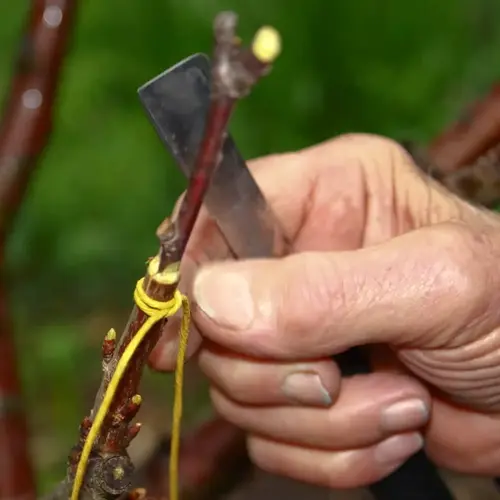Comprehensive Guide to Identify Plant Diseases

Written by
Nguyen Minh
Reviewed by
Prof. Charles Hartman, Ph.D.Understand plant disease by assessing the difference between biotic pathogens and abiotic disorders
Identify behavioral characteristics like lesions, drooping, and discoloration to diagnose disease accurately
Use structured visual assessment procedures to find early signs of disease
Use AI-based identification apps to assist with instant analysis of your plant disease
Identify and refute common myths related to the treatment of plant disease so that you can create a management technique that works
Combine both your clumsy observation skills- with neat modern technology, to better protect your plant!
Article Navigation
As you stand in your garden, you notice yellowing of the plants and wonder how to recognize plant diseases correctly. It seems like just yesterday that I grew my first crop of tomatoes and lost it because I thought that fungal spots were sunburn. It is a wasted motion of both time and money when the diseases are wilfully allowed to spread unnoticed.
Misdiagnosing plant problems results in crop loss and needless treatments. During one season, I treated nutrient-starved peppers with fungicide, but it did more harm than good. Today, modern tools enable expert diagnosis for all plants, from patio herbs to field managers.
This manual demonstrates how to develop accurate symptom recognition and smart inspection techniques, how to utilize diagnostic apps effectively, and how to avoid common misconceptions. Early recognition of symptoms, such as negative spots or wilting, saves plants from becoming irreversibly harmed.
Biotic vs. Abiotic Diseases Explained
Plant diseases are categorized into biotic diseases, which are caused by living pathogens, and abiotic diseases, which are caused by environmental stresses. Biotic diseases may be spread from plant to plant via fungi, such as the powdery mildews, or bacteria, such as fire blight. For example, I have observed tomato viruses spreading from plant to plant in my greenhouse during the growing season, and quarantine measures have been applied to restrict the spread of these viruses.
Abiotic disorders are more localized and result from factors such as nutrient deficiency or pH imbalance. My hydrangeas experienced iron chlorosis last summer due to changes in the soil pH following heavy rains. Unlike biotic diseases, these won't spread to neighboring plants, but still can weaken your plants considerably.
Correct diagnosis matters because treatments are entirely different. For biotic diseases, you need containment and pathogen control like copper sprays. For abiotic problems, you need habitat correction, for example, compost or irrigation changes. A misdiagnosis of plant pressure led me to spray plant disease control on sun-scorched plants, resulting in wasted effort and a loss of soil health.
Check whether symptoms spread or remain localized. Generally, biotic disturbances exhibit a predictable pattern of spread. In contrast, abiotic damage does not spread but remains constant after the initial damaging event. Correct diagnosis of the problem will not only save your plants but also prevent unnecessary use of chemicals in your garden.
Biotic Diseases
- Pathogens include living organisms such as fungi, bacteria, viruses, and nematodes that attack plants
- These diseases spread through contact between plants or via vectors like insects and contaminated tools
- Symptoms often progress from initial infection points and may show visible microbial growth
- Effective management requires specific treatments targeting the pathogen and preventing further transmission
- Common examples include rust, powdery mildew, and bacterial leaf spot affecting various plant species
- Diagnosis may require microscopic examination or laboratory culturing to confirm pathogen identity
Abiotic Diseases
- Caused by physical or chemical factors including temperature extremes, moisture imbalance, or soil toxicity
- Symptoms appear uniformly across plants exposed to identical environmental stress conditions
- Diagnosis involves testing soil composition, drainage patterns, and local weather history records
- Solutions focus on modifying growing conditions rather than targeting biological agents
- Typical cases include sunscald, fertilizer burn, and winter injury showing consistent damage patterns
- Prevention relies on monitoring environmental factors and adjusting cultivation practices proactively
Transmission Vectors
- Biotic transmission occurs through insects, contaminated water, wind-blown spores, or infected tools
- Abiotic factors cannot spread but intensify through persistent environmental conditions like poor drainage
- Human activities like improper pruning or over-fertilization often exacerbate both disease categories
Diagnostic Tools
- Biotic identification uses microscopic examination, PCR tests, and antibody-based detection methods
- Abiotic diagnosis employs soil pH meters, moisture sensors, and leaf tissue nutrient analysis kits
- Field scouting combined with weather data helps distinguish between biotic and abiotic stressors
Prevention Strategies
- Biotic prevention: Resistant cultivars, crop rotation, sanitation, and biological control agents
- Abiotic prevention: Soil amendments, irrigation management, windbreaks, and proper fertilization schedules
- Integrated approaches include monitoring systems and maintaining optimal plant health for resilience
Common Symptoms of Plant Diseases
Leaves frequently show the first signs of disease. You may see circular spots (spotting begins small, becomes larger, and colored halos become visible). Early blight on my tomatoes began as small, brown spots, which later coalesced to form large, dead areas on the leaves. Check for uniformity of size or clustering, which helps differentiate between environmental stress and disease presence.
Stems disclose troubles through "cankers" or "abnormal growths." In stone fruits, the bacterial canker shows in "oozing spots" girding the branches. In one instance, I recall, I failed to notice the early peach tree galls because I thought they were normal knobs. Also, examine the brittle stems and cracked bark, especially after early winter frosts.
The underlying causes show as dwarfed growth or sudden damping off. My zucchini became soft and fell over, even with moist soil, because Pythium root rot made my roots mushy. Carefully dig around the base and examine the roots. Good roots are white or light in color and firm, while diseased roots are black and slimy.
It is not unusual for fruit diseases to show symptoms in combination. Blossom end rot exhibits scabby, leathery spots with fungal growth, indicating a calcium deficiency and fungal attack. Little signs, such as the slight puckering of fruit skin, are often overlooked by beginners. It is advisable to keep a weekly record of symptom development, as rapid progression is a sign of aggressive pathogens that require prompt action.
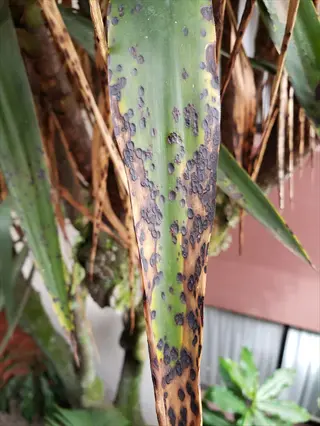
Leaf Spots
- Appearance: Circular or irregular brown, yellow, or black marks appearing on foliage surfaces, varying in size and distribution patterns
- Common causes: Fungal infections like anthracnose thrive in humid conditions while bacterial leaf spot spreads through water splashes
- Progression: Small isolated spots initially form, gradually expanding outward with distinctive colored halos developing around margins
- Plant impact: Significantly reduces photosynthetic capacity by damaging leaf tissue, progressively weakening the plant's overall growth and vigor
- Diagnostic tip: Uniform spot patterns often indicate environmental stress while clustered irregular spots suggest biological pathogen activity
- Management: Prune and dispose of affected foliage, apply copper-based fungicide treatments, and improve air circulation around plants
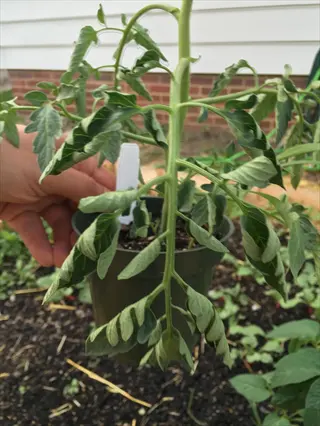
Wilting
- Appearance: Persistent drooping of leaves and stems despite adequate soil moisture, progressing from slight sagging to complete collapse
- Common causes: Root rot diseases impair water uptake, vascular wilts block internal systems, or drought stress damages root functionality
- Progression: Initial mild wilting during hottest daylight hours advances to permanent wilting that continues through cooler nighttime periods
- Plant impact: Disrupts essential water and nutrient transportation systems, frequently leading to irreversible damage and plant mortality
- Diagnostic tip: Carefully examine root systems for dark discoloration or mushy texture which confirms soil-borne disease involvement
- Management: Enhance soil drainage with organic amendments, implement crop rotation schedules, and select disease-resistant plant varieties
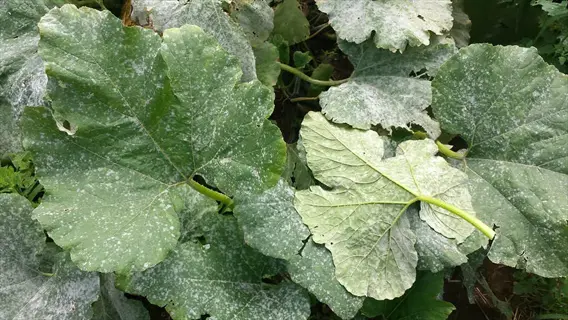
Powdery Residues
- Appearance: Distinctive white or gray powdery fungal growth covering upper leaf surfaces, sometimes extending to stems and buds
- Common causes: Various powdery mildew fungi species proliferate during moderate temperatures combined with high humidity conditions
- Progression: Begins as tiny isolated white patches that rapidly coalesce into continuous sheets covering entire leaf surfaces
- Plant impact: Creates physical barriers that block sunlight absorption, resulting in diminished growth rates and reduced crop yields
- Diagnostic tip: Superficial fungal growth wipes away temporarily but quickly reappears, distinguishing it from natural leaf coatings
- Management: Increase spacing between plants for better airflow, apply regular sulfur sprays, and remove severely infected plant parts
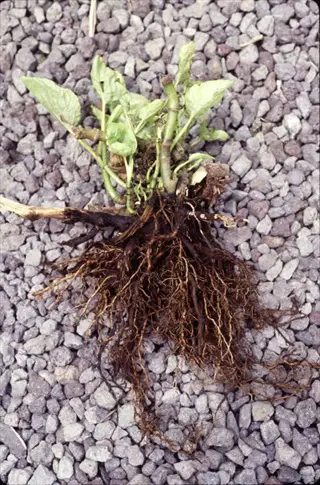
Root Rot
- Appearance: Roots transform from healthy white to dark brown or black, developing mushy consistency accompanied by foul odors
- Common causes: Prolonged soil saturation from overwatering, inadequate drainage systems, or pathogenic organisms like Pythium species
- Progression: Root discoloration starts at tips, advancing toward crown as tissues lose structural integrity and disintegrate
- Plant impact: Severely compromises root system functionality, preventing absorption of essential water and dissolved soil nutrients
- Diagnostic tip: Gently excavate soil near symptomatic plants to inspect root coloration, texture, and structural integrity
- Management: Adjust irrigation schedules significantly, incorporate coarse sand or perlite into soil, and apply biological fungicides

Stunted Growth
- Appearance: Noticeably reduced plant size with smaller-than-normal leaves and shortened distances between stem connection points
- Common causes: Nutrient deficiencies particularly nitrogen, compacted soil restricting root development, or systemic viral infections
- Progression: Newest growth emerges significantly undersized while existing older growth may initially appear relatively unaffected
- Plant impact: Dramatically reduces potential yield quantity and quality through impaired photosynthesis and resource utilization
- Diagnostic tip: Compare affected plants with healthy specimens of identical age and variety growing under similar conditions
- Management: Conduct comprehensive soil nutrient analysis, incorporate balanced organic compost, and address soil compaction issues
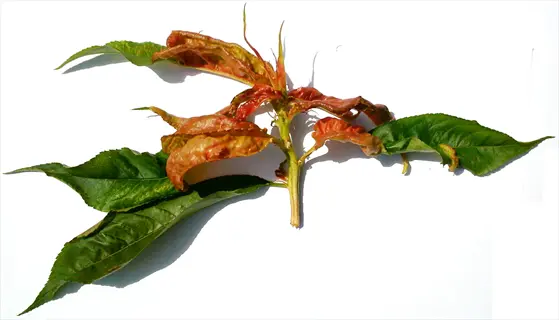
Leaf Curling
- Appearance: Upward or downward curling distortion along leaf margins, sometimes accompanied by blistering or thickened areas
- Common causes: Viral pathogens transmitted by insects, herbicide exposure damage, or aphid feeding activities on undersides
- Progression: Mild initial curling intensifies to severe distortion, potentially causing complete leaf rolling in advanced stages
- Plant impact: Substantially reduces effective photosynthetic surface area and impairs normal plant metabolic processes
- Diagnostic tip: Thoroughly inspect curled leaf undersides for tiny insects or characteristic stippling patterns from feeding
- Management: Remove and destroy infected plants immediately, implement insect control measures, and avoid herbicide drift
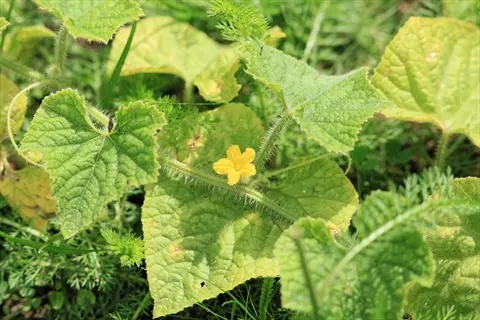
Yellowing Leaves
- Appearance: Chlorosis manifesting as yellow discoloration starting between veins or affecting entire leaves uniformly
- Common causes: Nitrogen deficiency limiting chlorophyll production, excessive soil moisture, or root disease impairing function
- Progression: Typically begins with older lower leaves, gradually progressing upward to affect newer growth as deficiency worsens
- Plant impact: Signals disruption in essential metabolic processes, eventually reducing plant vigor and reproductive capabilities
- Diagnostic tip: Uniform yellowing suggests nutritional issues while mottled patterns indicate possible viral infection involvement
- Management: Adjust fertilizer application schedules, conduct soil pH testing, and improve drainage conditions around root zones

Galls/Knots
- Appearance: Abnormal swollen growths developing on stems, roots, or branches ranging from small bumps to large woody tumors
- Common causes: Bacterial infections like crown gall, fungal growths, or insect-induced irritation triggering abnormal cell division
- Progression: Small initial swellings gradually enlarge over weeks or months, sometimes cracking bark as they expand
- Plant impact: Physically disrupts vascular tissue function, weakening structural support and nutrient transport capabilities
- Diagnostic tip: Note precise location since crown galls form near soil while stem knots occur higher on plant structures
- Management: Prune affected plant sections during dormancy, sterilize tools between cuts, and avoid unnecessary plant wounding
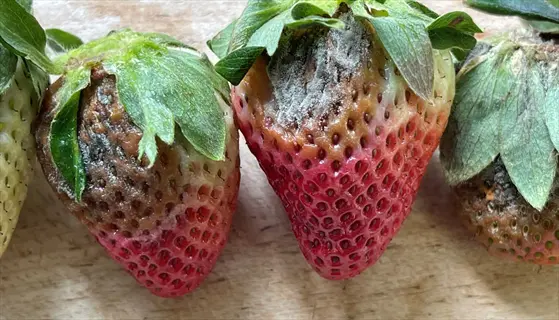
Mold Growth
- Appearance: Fuzzy gray, brown, or white mold colonizing fruits, flowers, or senescing tissues, often with visible spore masses
- Common causes: Botrytis cinerea and related fungi flourishing under cool, humid conditions with poor air movement
- Progression: Infection begins on damaged or dying plant tissues, rapidly spreading to healthy adjacent tissues within days
- Plant impact: Causes rapid decay and rotting of reproductive structures, leading to substantial harvest losses in crops
- Diagnostic tip: Characteristic musty odor accompanies infection, helping distinguish from other fruit rot conditions
- Management: Increase spacing between plants, promptly remove plant debris, and handle fruits carefully to prevent bruising
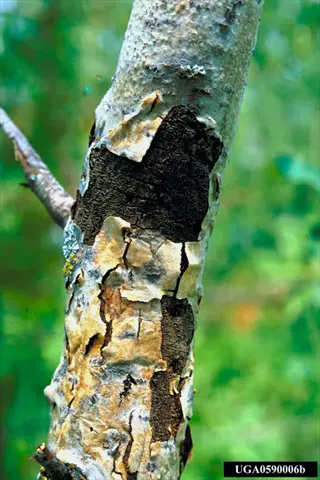
Oozing/Cankers
- Appearance: Sunken necrotic lesions on bark with sticky or sappy exudates ranging from clear to amber or dark brown
- Common causes: Bacterial or fungal pathogens entering through wounds, frost cracks, or improper pruning injury sites
- Progression: Small localized lesions gradually expand, sometimes girdling entire stems or branches leading to dieback
- Plant impact: Disrupts vascular flow systems, causing progressive decline in affected limbs and potentially whole plants
- Diagnostic tip: Ooze color varies significantly by pathogen type and can indicate specific disease organisms present
- Management: Sterilize pruning tools between every cut, surgically remove infected bark areas, and apply protective wound sealants
Step-by-Step Visual Inspection Guide
Be prepared for inspection by collecting major tools: a 10x magnifying glass detects small pests or lesions, your smart phone camera records changes, and a soil probe checks moisture levels deep down. I keep them all at hand in my garden apron for quick use while walking through the crops.
Begin inspections from the highest point and work downward. Inspect the leaves of the vegetables daily, as downy mildew and other diseases can spread rapidly. Trees need to have their trunks inspected every month for oozing cankers. Note the progress of symptoms in affected areas by regularly photographing them every three days, observing changes in size and color.
Keep an orderly record of everything. Daily records should be made of the various locations of the symptoms and of the weather. I use a waterproof notebook and draw a grid of the fields, and mark the affected areas on it. This way, I learn of such things as where the fungus developed quickly after rain. This checks up some of my diagnoses.
Adapt strategies according to your plants. Squash leaves rapidly display powdery mildew, while citrus trees hide scale insects under branches. Examine the soil weekly for annuals, but check perennial roots only seasonally. Keeping thorough notes makes clear subtle changes noticeable to the beginner.
Preparation and Initial Observation
- Gather essential tools including a 10x magnifying lens, digital camera with macro capability, and waterproof notebook for recording observations
- Begin by examining the plant from 3-5 feet (0.9-1.5m) distance to note overall symmetry, growth patterns, and visible abnormalities
- Document environmental conditions: record current temperature, recent rainfall patterns, and sunlight exposure duration
- Establish consistent documentation using dated photographs and symptom progression charts
Leaf Examination Protocol
- Systematically inspect both upper and lower leaf surfaces using magnification, checking for spots, discoloration, or texture changes
- Note patterns: clustered spots may indicate pathogens while uniform yellowing suggests environmental stress
- Measure affected area percentage by comparing damaged sections to overall leaf surface using grid references
- Collect representative samples placing them in sealed plastic bags with damp paper towels to preserve freshness
Stem and Branch Inspection
- Examine stems for lesions, cankers, or oozing sap at multiple height intervals using gloved hands for tactile assessment
- Check for structural weaknesses by gently flexing branches while noting any unusual brittleness or flexibility
- Inspect bark for cracking patterns, discolored patches, or abnormal swelling using directional lighting
- Document findings with close-up photography including scale references like rulers or common objects
Root and Soil Assessment
- Carefully excavate soil around the root zone using a hand trowel to examine root coloration and texture without causing damage
- Evaluate soil moisture at different depths using a probe while checking for compaction layers or drainage issues
- Test soil pH with portable meter and collect samples for laboratory nutrient analysis if resources allow
- Assess root architecture noting distribution patterns, discoloration, and signs of girdling or circling roots
Symptom Correlation and Analysis
- Cross-reference findings across all plant parts looking for connections between leaf symptoms and root conditions
- Compare observations with healthy reference plants of the same species grown under similar conditions
- Analyze symptom progression patterns using dated photographs to determine development speed and spread
- Compile comprehensive report including environmental factors, visual documentation, and preliminary diagnosis
Top Plant Disease Identification Apps
Plant disease apps provide fundamental functions such as instant disease identification, treatment recommendations, and pest control guidance. Agrio excels with alerts based on weather, predicting the timing of pest outbreaks, whereas Blossom provides reminders for watering plants. Farmers gain the greatest benefit from features that integrate pest management in ways that prevent total crop devastation.
Unique features make apps stand out. Plantix is equipped with regional epidemic maps, and PictureThis connects you with humans. Offline modes in Plant. I'd operate in the countryside where there is no signal. Home gardeners appreciate Plantora's simple user-friendliness, which enables them to quickly check their balcony plants with ease.
Check platform availability prior to decision. Galaxy.ai has instantaneous availability in a browser, while iOS selects Blossom's interfaces. I use Agrio on Android during surveys on the farm, but I transfer to the web-based Plant.id for sample analyses at home. This ensures compatibility between devices.
Tailor apps to your needs. Home gardeners want straightforward options such as Blossom's simple care reminders. Farmers need comprehensive programs like Plantix's social community and geo-referenced reports. Check out free samples first, as different costs and types of premium features are available.
Accuracy Factors
- Database size: Apps with 10,000+ expert-verified images provide more reliable identifications
- Update frequency: Regular algorithm improvements based on new disease data enhance accuracy
- Regional specificity: Apps offering location-based filtering account for geographic variations
Usability Features
- Offline functionality: Essential for field use in areas with poor internet connectivity
- Multilingual support: Critical for non-English speaking agricultural communities
- Accessibility options: Voice commands and high-contrast modes assist diverse users
Treatment Guidance
- Organic options: Apps recommending neem oil or bacillus thuringiensis support eco-friendly gardening
- Chemical alternatives: Precise dosage calculators prevent over-application of pesticides
- Cultural practices: Crop rotation and sanitation advice for long-term prevention
Data Privacy
- Image ownership: Clear policies on whether user photos are added to public databases
- Location sharing: Opt-in requirements for geotagging disease reports
- Data encryption: SSL/TLS protection for personal information and uploads
Cost Structure
- Free tiers: Basic scanning without paywalls for essential identification
- Premium features: Subscription-based expert consultations or advanced diagnostics
- Educational discounts: Special pricing for schools and agricultural programs
How AI Apps Work: Behind the Scenes
Consider AI neural networks as the roots of a plant exploring its environment. Each layer processes images in the same way that roots gather nutrients from the earth. The convolutional layers detect base patterns, just like the edges of leaves. The pooling layers simplify the details, just as the roots filter out the important minerals from the soil.
Training marries expert tagging and real-world validation. Developers feed millions of images tagged by botanists. Then they test the AI against real garden shots I submit. This combination catches mistakes like mistaking sunburn for fungal spots.
The isolation of symptoms clarifies the problem. The diseased portions are separated from the healthy tissues using algorithms, and they prune out the affected branches, much like pruning shears. Color changes and texture changes are examined, and the blemishes concealed among the veins or soil splashes on the leaves are determined.
Apps are continuously learning from user feedback. Whenever you are flagging misidentifications, they're actually retraining models every week. My contributions to correcting local rose diseases increased the accuracy of Agrio for a presumably large region. This ongoing updating enables each app to become increasingly smarter with each passing season.
Image Processing Pipeline
- Background removal algorithms isolate plant structures from soil and debris using edge detection techniques
- Symptom segmentation identifies affected areas through pixel clustering and color thresholding analysis
- Multi-angle reconstruction creates 3D models from 2D images to assess symptom depth and progression
- Noise reduction filters eliminate shadows, water droplets, and insect interference for clearer diagnosis
Neural Network Architecture
- Convolutional layers detect basic patterns like edges and textures in initial processing stages
- Pooling layers reduce spatial dimensions while retaining critical symptom features for efficiency
- Recurrent layers analyze sequential data progression for diseases showing temporal patterns
- Classification layers output probabilities for specific diseases using softmax activation functions
Training Methodology
- Dataset curation: Expert-tagged images covering thousands of plant species and disease combinations
- Transfer learning: Adaptation of models pretrained on large-scale image recognition tasks
- Data augmentation: Synthetic generation of variations in lighting, angles, and symptom stages
- Cross-validation: Testing across geographical regions to ensure global applicability
Symptom Recognition
- Pattern analysis: Distinguishing between biotic spots (irregular) vs. abiotic damage (uniform)
- Color histogram comparison: Matching discoloration profiles against known disease signatures
- Texture mapping: Identifying fuzzy growths indicative of fungi versus smooth bacterial ooze
- Spatial distribution: Analyzing clustering patterns that differentiate pest damage from pathogens
Continuous Improvement
- User feedback loops: Reporting misidentifications to retrain models regularly
- Regional adaptation: Customizing algorithms for local disease prevalence and plant varieties
- Symptom progression tracking: Correlating early-stage identifications with later developments
- Cross-platform collaboration: Enhancing global knowledge through aggregated anonymized data
5 Common Myths
All fungi growing on plants are harmful parasites that must be removed now.
Many fungi develop mutually beneficial relationships with plants, such as mycorrhizal networks that aid in the absorption of nutrients and drought resistance. Removal of these beneficial fungi will weaken plants by eliminating necessary soil ecosystems that promote root health and growth.
Plant diseases manifest conspicuous visible symptoms immediately after infection.
Various plant pathogens infect plants on a latent basis, causing them to carry disease for weeks or months without showing visible symptoms. Viruses in particular diffuse from plants by means of their insect vectors in a latent manner without other symptoms, and it is difficult to make a diagnosis because the characteristic symptoms such as mosaics or stunting will not show.
Organic treatments do not effectively treat serious plant diseases.
When properly applied, organic treatments can be very effective: neem oil interferes with the germination of funguses and the breeding cycle of insects. The bacteria Bacillus thuringiensis attack specific insects, but do no damage to beneficial insects. Treatments work as a preventive measure and a curative when made a part of the normal treatment of established plants and offer sustainable long term protection from disease.
No laboratory testing is ever necessary to yield perfectly accurate plant disease diagnosis results.
Today, approximately 70% of common disease cases are solved solely by AI applications based on visual observations through recognition of images trained by millions of professionally vetted examples, laboratory results remain important in the case of rare pathogens, though not necessary for most garden diseases which can be identified by summary presentations and environment particularities.
Plants exhibiting severe symptoms of disease cannot be salvaged and should be discarded immediately.
Many plants can be salvaged successfully by intelligently pruning the diseased portions with soil treatment and appropriate fungicide, for a success ratio of approximately sixty percent. Even badly diseased plants can frequently be rejuvenated by putting them back into strong root systems in soil after they are given proper care and nourishment and allowed parks of time for vitality and recuperation.
Conclusion
Identifying plant problems quickly makes all the difference. I saved my rose garden by discovering black spot fungus before it had a chance to spread. You can eliminate crop loss and costly treatments by discovering changes like wilting or spots within a few days.
Blend old-fashioned observation with new technology. Walk through your garden every day, examining the leaves, and refer to apps like Plantix for immediate information and analysis. This way, you can know an expert, whether you are growing vegetables or flowers.
Make sure to incorporate plant inspection into your routine. Consider setting weekly notifications to take pictures and document any changes that you see. Personally, I observe my greenhouse every Tuesday morning. By continuously monitoring plants, one can catch diseases. At the same time, they are still manageable, which can prevent the loss of both time and plants.
You have the power to save sick plants. With the knowledge and tools you have, you can transform problems into thriving solutions. Start today by paying close attention to one plant and applying what you have learned. Your garden will show its appreciation by becoming healthy and beautiful.
External Sources
Frequently Asked Questions
How do you identify plant diseases?
Identify plant diseases by examining symptoms like leaf spots, wilting, discoloration, and abnormal growths. Compare symptoms against disease databases, noting progression patterns. Use systematic inspection techniques covering leaves, stems, and roots for comprehensive analysis.
What are common signs of plant diseases?
Common disease indicators include:
- Irregular leaf spots or discoloration
- Wilting despite proper watering
- Powdery or fuzzy fungal growths
- Stunted growth patterns
- Root rot with dark, mushy roots
How effective are plant disease identification apps?
Plant disease apps provide reliable identification for common issues using AI-trained databases. Effectiveness depends on image quality and symptom clarity. They offer treatment suggestions but complex cases may require professional lab analysis for definitive diagnosis.
Can smartphone cameras diagnose plant diseases?
Smartphone cameras enable preliminary disease identification when used with AI apps. Capture clear images of symptoms from multiple angles under good lighting. While convenient, severe or unusual cases require expert verification for accurate diagnosis.
What should I do after identifying a plant disease?
After identification:
- Isolate affected plants immediately
- Apply targeted treatments like fungicides
- Adjust environmental conditions causing stress
- Remove severely infected plant parts
- Monitor recovery progress systematically
Are free plant identification tools reliable?
Free tools offer basic identification capabilities but have limitations. They work well for common diseases with clear symptoms. For rare pathogens or ambiguous cases, paid versions or expert consultation provide greater diagnostic accuracy.
How can I prevent misdiagnosing plant problems?
Prevent misdiagnosis by:
- Comparing symptoms across multiple sources
- Documenting progression with dated photos
- Testing soil and environmental factors
- Cross-referencing app results with gardening resources
- Consulting agricultural extensions when uncertain
What's the difference between biotic and abiotic diseases?
Biotic diseases stem from living pathogens like fungi and spread between plants. Abiotic issues result from environmental stressors like nutrient deficiencies and remain localized. Identification determines treatment: pathogen control versus habitat correction.
Can plants recover from advanced disease symptoms?
Plants often recover from advanced symptoms through strategic intervention. Prune infected areas, adjust growing conditions, and apply appropriate treatments. Many regenerate from healthy root systems when given proper care and sufficient recovery time.
How often should I inspect plants for diseases?
Conduct thorough inspections:
- Weekly during active growing seasons
- After extreme weather events
- When introducing new plants
- During seasonal transitions
- At first sign of abnormalities
